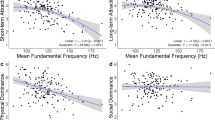Abstract
This paper employs a cue synthesis experimental method to examine the effects of pitch and intonation on male vocal attractiveness to women. Voices were acoustically manipulated to yield nine combinations of three levels of average fundamental frequency and three levels of variance of fundamental frequency. Strong main effects were obtained for the average fundamental frequency manipulation, with high voices rated as significantly less attractive to women than either medium or low voices, which do not differ in attractiveness. The main effects of manipulations of variance of fundamental frequency on vocal attractiveness and benevolence did not reach significance, but there was a significant interaction on the benevolence factor, with high or low average fundamental frequency manipulations being rated particularly low for voices with low variance of fundamental frequency.

Similar content being viewed by others
References
Addington D. W. (1968). The relationship of selected vocal characteristics to personality perception. Speech Monographs, 35, 492–503.
Apple W., Streeter L. A., & Krauss R. M. (1979). Effects of pitch and speech rate on personal attributions. Journal of Personality and Social Psychology, 37, 715–727.
Barber N. (1995). The evolutionary psychology of physical attractiveness: Sexual selection and human morphology. Ethology and Sociobiology, 16, 395–424.
Brown B. L. (1980). Effects of speech rate on personality attributions and competency evaluations. In: H. Giles, W. P. Robinson, P. M. Smith (Eds.), Language: Social psychological perspectives: Selected proceedings of the first international conference on social psychology and language held at the University of Bristol, England, July, 1979 (pp. 293–300). Oxford: Pergamon Press.
Brown B. L., Strong W. J., & Rencher A. C. (1973). Perceptions of personality from speech: Effects of manipulations of acoustical parameters. Journal of the Acoustical Society of America, 54, 29–35.
Brown B. L., Strong W. J., & Rencher A. C. (1974). Fifty-four voices from two: the effects of simultaneous manipulations of rate, mean fundamental frequency, and variance of fundamental frequency on ratings of personality from speech. Journal of the Acoustical Society of America, 55, 313–318.
Buss D. M. (1989). Sex differences in human mate preferences: Evolutionary hypotheses tested in 37 cultures. Behavioural and Brain Sciences, 12, 1–49.
Collins S. A. (2000). Men’s voices and women’s choices. Animal Behaviour, 60, 773–780.
Dabbs J. M. Jr., & Mallinger A. (1999). High testosterone levels predict low voice pitch among men. Personality and Individual Differences, 27, 801–804.
Raines R. S., Hechtman S. B., & Rosenthal R. (1990). Physical attractiveness of face and voice: Effects of positivity, dominance, and sex. Journal of Applied Social Psychology, 20, 1558–1578.
Ray G. B., Ray E. B., & Zahn C. J. (1991). Speech behavior and social evaluation: An examination of medical messages. Communication Quarterly, 2, 47–57.
Scherer K. R. (1979a). Personality markers in speech. In: K. R. Scherer & H. Giles (Eds.), Social markers in speech (pp. 147–209). Cambridge: Cambridge University Press.
Scherer K. R. (1979b). Voice and speech correlates of perceived social influence in simulated jury. In: H. Giles & R. N. St Clair (Eds.), Language and social psychology (pp. 88–120). Baltimore: University Park Press.
Tuomi S. K., & Fisher J. E. (1979). Characteristics of a simulated sexy voice. Folia Phoniatrica, 31, 242–249.
Zuckerman M., & Miyake K. (1993). The attractive voice: What makes it so? Journal of Nonverbal Behavior, 17, 119–135.
Zuckerman M., Miyake K., & Elkin C. S. (1995). Effects of attractiveness and maturity of face and voice on interpersonal impressions. Journal of Research in Personality, 29, 253–272.
Author information
Authors and Affiliations
Corresponding author
Rights and permissions
About this article
Cite this article
Riding, D., Lonsdale, D. & Brown, B. The Effects of Average Fundamental Frequency and Variance of Fundamental Frequency on Male Vocal Attractiveness to Women. J Nonverbal Behav 30, 55–61 (2006). https://doi.org/10.1007/s10919-006-0005-3
Published:
Issue Date:
DOI: https://doi.org/10.1007/s10919-006-0005-3



